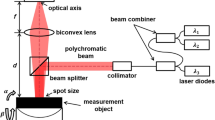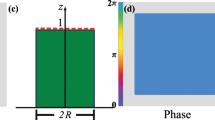Abstract
The paper discusses the spectral correlation of the speckle patterns that have been produced by illuminating different surfaces with the diode laser at different tuning range of wavelengths. The diode laser could induce a shift in the wavelength value by raising the temperature of the laser cavity using a temperature controller. Young’s interference fringes could be obtained by applying the Fast Fourier transform to the spectral correlated speckle patterns, and the visibility of the interference fringes was found to be proportional to the surface roughness values of the objects of interest and the deviation in the wavelengths used in the illumination. Both the experimental and theoretical values of the standard surfaces used in the experimental work were compared. The system of the speckle photography and the diode laser as a coherent illuminating source provided good accuracy for measuring the surface roughness values greater than 1 µm. Theory, method, results, and uncertainty are presented in details.




Similar content being viewed by others
References
N. Russo, N. Bolognini, E. Sicre and M. Garavaglia, Surface roughness measurement through a speckle method, Int. J. Optoelectron., 5 (1990) 389–395.
D. Jason, Characterization of thick optically scattered media with laser speckle and a tunable coherence source, Master Thesis, Purdue University (1999).
J. Gelbert, T. Dudderar and J. Bennewitz, The application of fiber optics to remote speckle metrology using incoherent light, Opt. Lasers Eng., 3 (1982) 183–195.
J.C. Davies and C.H. Buekberry, Application of electronic speckle pattern interferometry in automotive product development, VDI Ber., 617 (1986) 279–293.
R.P. Tatam, Optical fiber sensor technology, Chapman & Hall, London (1998).
R.P. Tatam, J.C. Davies, C.H. Buckberry and D.C. Jones, Holographic surface contouring using wavelength modulation of laser diodes, Opt. Laser Technol., 22 (1990) 317–321.
J.R. Huang, H.D. Ford and R.P. Tatam, Slope measurement by two wavelength electronic shearography, Opt. Lasers Eng., 27 (1997) 321–333.
K. Galannlis, T. Bunkas and R. Ritter, Active stabilisation of ESPI systems for applications under rough conditions, Proc. SPIE, 2545 (1995) 103–107.
A. Wei, Industrial Applications of Speckle Techniques - Measurement of Deformation and Shape, Doctoral Thesis, Royal Institute of Technology Department of Production Engineering Chair of Industrial Metrology & Optics, Sweden (2002).
M. Jakobi, Laser speckle based surface measurement techniques relevant to fusion devices, Doctor-Ingenieurs, Fakultät Für Elektrotechnik und Informationstechnik der Technische Universität München (2000).
D. Leger, E. Mathieu and J.C. Perrin, Optical surface roughness determination using speckle correlation technique, Appl. Opt., 14 (1975) 872–877.
L. Tchvialeva, Surface roughness measurement by speckle contrast under the illumination of light with arbitrary spectral profile, Opt. Lasers Eng., 48 (2010) 774–778.
N. George and A. Jain, Space and wavelength dependence of speckle intensity, Appl. Phys., 4 (1974) 201–212.
N. George, A. Jain and J. Melville, Experiments on the space and wavelength dependence of speckle, Appl. Phys., 7 (1975) 157–169.
N. George, The wavelength sensitivity of back-scattering, Opt. Commun., 16 (1976) 328–333.
N. George, Speckle from rough, moving objects, J. Opt. Soc. Am., 66 (1976) 1182–1194.
N. George, A.C. Livanos, J.A. Roth and C.H. Papas, Remote sensing of large roughened spheres, Opt. Acta, 23 (1976) 367–387.
N. George and A. Jain, Speckle reduction using multiple tones of illumination, Appl. Opt., 12(5) (1973) 1202–1212.
E.M. Strzelecki, D.A. Cohen and L.A. Coldren, Investigation of tunable single frequency diode lasers for sensor applications, J. Light. Technol., 6 (1998) 1610–1618.
J.C. Marron and K.S. Schroeder, Three-dimensional lensless imaging using laser frequency diversity, Appl. Opt., 31 (1992) 55–262.
L.G. Shirley and P.A. Lo, Bispectral analysis of the wavelength dependence of speckle: remote sensing of object shape, Opt. Soc. Am., 11 (1994) 1025–1046.
L.G. Shirley and G.R. Hallerman, Applications of Tunable Lasers to Laser Radar and 3D Imaging, Technical Report 1025, MIT Lincoln Laboratory, DTIC #AD-A306557 (1996).
JCGM 100, Evaluation of measurement data —Guide to the expression of uncertainty in measurement (2008), http://www.bipm.org/utils/common/documents/jcgm/JCGM_100_2008_E.pdf.
Author information
Authors and Affiliations
Corresponding author
Rights and permissions
About this article
Cite this article
Farid, N., Hussein, H. & Bahrawi, M. Employing of Diode Lasers in Speckle Photography and Application of FFT in Measurements. MAPAN 30, 125–129 (2015). https://doi.org/10.1007/s12647-014-0128-7
Received:
Accepted:
Published:
Issue Date:
DOI: https://doi.org/10.1007/s12647-014-0128-7




